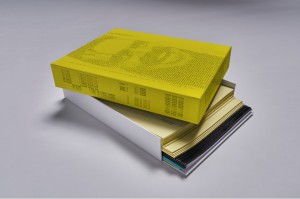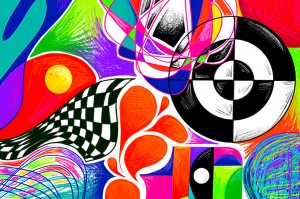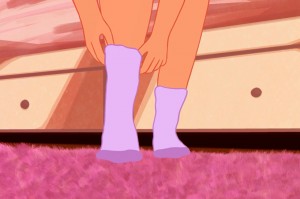The Big Interview: Jonathan Boyd, Head of Programme for Jewellery & Metal MA (JaM) at the Royal College of Art

Pushing the idea of jewellery to breaking point, Royal College of Art tutor Jonathan Boyd is encouraging the next generation of designers and artists to exponentially challenge their practice. He tells Laura Robertson about the experimentation, the expertise, and the RCA’s dedicated postgraduate scholarship for British silversmiths…
Originally from Aberdeen, Jonathan Boyd has spent most of his life in Glasgow. Talking to me over Zoom, he sits on an iconic orange and red 1980s Glasgow bus seat, which reminds me of the Liverpool buses I grew up with. The walls behind him are plastered with pages of handwriting, photographs and ink drawings. It’s not what I expected from a jeweller – but what was I expecting?
Head of Programme for Jewellery & Metal MA (JaM) at the Royal College of Art, I was interested to find out how Boyd’s own artwork impacts his students. His recent exhibition – Thoughts Between the Land and the Sea: Raising the Doggerland – featured animations, spoken word, sculptures, texts and sketchbooks.
A multi-award-winning artist, jeweller and academic, Boyd was a lecturer at the Glasgow School of Art for nine years and he has degrees from the RCA and GSA. His work is in the Victoria and Albert Museum and the Boston Museum of Fine Arts collections. He is represented by Gallery Marzee in The Netherlands.
TDN: You’re making work about language and object, can you expand on that?
JB: So I’m sort of a jeweller, but I’m probably working on the edges of jewellery and fine art. It’s a weird place to be, but I’m interested in jewellery as an art form because it connects with the body and the person in really strange ways. My own practice was sort of driven by a neurodivergent inability to read when I was growing up, and I became fascinated by typography and the image of language.
It’s no surprise, then, that your RCA2023 graduate show really pushed at what we’d conceive as jewellery and metal work. There was a social distancing belt made of arms, animations of dreams, a bikini made from feathers and gold…
Yes, there were so many incredible makers. Two people who for me exemplify what we were doing are Lili Murphy-Johnson, who was the first Jewellery & Metal student to be nominated as a Bloomberg New Contemporary, who would buy cheap earrings from Accessorize and remake them in fine gold, and put them back in the shop; and Elaheh Naghi Ganji, who was making incredibly powerful, quiet pieces, where she was writing protest letters, using an eraser to rub them out, and then collecting those rubbings and turning them into pearls.

What about RCA2024? Can you introduce us to a couple of stand-out postgraduates?
So this year, one metal student is amazing, Yating Zheng. Inspired by her relationship with her Grandmother, she made this teapot which she talks to, slowly transformed through silver-smithing techniques, into this bodily, insane and amazingly-crafted teapot with a belly. Margo Misiak-Orlovic has made like a body of potatoes: it’s really strange but she’s looking at ways of thinking like a non-human. She’s been recording sound by submerging speakers in the ground, and made a series of jewellery objects and wall objects that are electroformed. The electroforming process is a lot like a type of rooting, growing, where you’ve got an object in a metal tank submerged in acid. An electric current is put through them and the metal reaches out to each other neurons or something crazy.
Jewellers, silversmiths and performance artists: all of whom are interested in the body and how we understand the world of things. Jewellery is something that connects, it is really symbiotic. You wear this ring because it symbolises something, but actually, it’s more than the symbol – it becomes you. And when you take it off, your body feels heavier.
And so there’s something there about our students understanding the world through jewellery, as a thought process, and through metal as a medium for expression.
It’s a progressive way of looking at jewellery and metal work that clearly fits with your own ideas of what it can be. What do you want to do with the programme moving forward?
We want to enable people to work across a spectrum of creative practices. We’ve got a lot of students working in biomaterials, looking at making things that are sustainable and ethical.
I’ve worked very closely with Dr Peter Oakley, who’s the RCA’s Reader in Material Culture. His area of interest is fair trade metals and so, together, we’ve created a research cluster, where all the staff come together. We share our research and it’s a lovely, peer relationship of understanding.
Because we were able to do that, we’re able to share really effectively with the students a teaching of ethics, carbon emissions, luxury goods sector, etc. For me, it’s about creating this type of jewellery thinking, which enables them to create their own approaches.

How about heritage or rare crafts, native crafts? I believe you offer a scholarship in British silver? Why?
The South Square Trust Scholarship is really important to us. What interests me about interdisciplinary work is that it comes from people working with real disciplinary expertise. Heritage is knowing, that tacit understanding of metal, and how it moves and how you shape it and how things are formed. Things move in different ways, depending on environmental pressures: silversmiths know that when you apply heat, things change. We want to keep that connection to our heritage alive, but also think, where does that discipline go now? What does it mean to be using these materials? There are still traditional vessels, but do we need to question their function? Do we need to question their environmental stability? Do we need to question?
So even just a teapot, although it’s made of aluminium, there’s something there about taking silversmithing and applying narrative to it and saying, actually, this object isn’t just this memory, this is familial, this is my life. You get it because it’s autobiography.
How do people apply for The South Square Trust Scholarship (for Home students using silver in their practice: £10,000 towards living costs)? What are you looking for in the MA application that would make them eligible?
It’s worth mentioning that this scholarship is still to be awarded for the 2024/25 academic year. It’s offered to a high scoring applicant to JaM, so anyone interested should apply asap!
We’re looking for people working in metal, who want to challenge and question their practice. I think so many people look to study an MA because they’ve been working for a long period of time, and they just need time to think. So often we’re taught in a certain way, especially in apprenticeships or undergraduate degrees, and you get to the point where you think, no, I need this to be something else and I need to reframe what I’m doing.
We are looking for applicants to highlight their craft skills; to show us the way that person sees the world. Tell us: how do you capture the world? How do you understand the world, visually, aesthetically, materially? So, if you’re taking photographs as research and then that develops into pieces of work, that development process is what we want to see and hear more about. Development shows us how you shift from an idea, through to how you progress, and back to idea to ‘thing’.
Try to articulate what is elemental to your practice, and how it’s developed, that’s it.


Would you also want to kind of hear what they specifically want to learn at the RCA, to push it to a step change?
Yeah, it’s good to have an idea of where you want to go. But knowing that when you come to the RCA, there’s a very good chance that your ideas will change fairly radically fairly quickly! Some people don’t study an MA because there isn’t a scholarship.
The RCA is renowned for its staff expertise. Tell me more about the technical and academic staff you work with.
We’ve got incredible facilities, stone cutting and a silversmithing room etc., but what’s really amazing is that our technical and academic staff are practising artists. They’re all working at the tops of their fields. People like Mary Ann Simmons, who has work in the British Museum and the Museum of Modern Art in New York. Pete Musson, not only is he a really well established silversmith, he works with companies as a design consultant, for Stella McCartney, Cubitts eyewear, Microsoft. Mah Rana, one of the key figures of contemporary jewellery in the 1990s, is now an expert in Psychology. Sophie Boons is studying a radical PhD where she’s growing rubies straight into rings. We are all questioning materials, and the meanings that come with material. The way we run the programme is that we break jewellery and metal into these smaller philosophies, that we call platforms. One of them is about digital; I run one about science and art; one is dedicated to metal. We’re really trying to foster an environment of critical working.
As told to Laura Robertson
Applications for the September 2024 intake of the Jewellery & Metal MA are still open, but places are limited. Visit the RCA website to find out more
Ask the RCA Student Team for advice about any scholarship, grant or bursary you might be eligible for… Including The South Square Trust Scholarship (for Home students using silver in their practice: £10,000 towards living costs)
See a host of RCA2024 exhibitions until 4 August 2024, across the RCA’s Battersea and White City campuses, and the Truman Brewery on Brick Lane. See here for more details
This article was sponsored by the RCA
Image credits from top: Yating Zheng (2024); Lili Murphy-Johnson (2023); Margo Misiak-Orlovic (2024); Jonathan Boyd, with work from Doggerland (2020)





